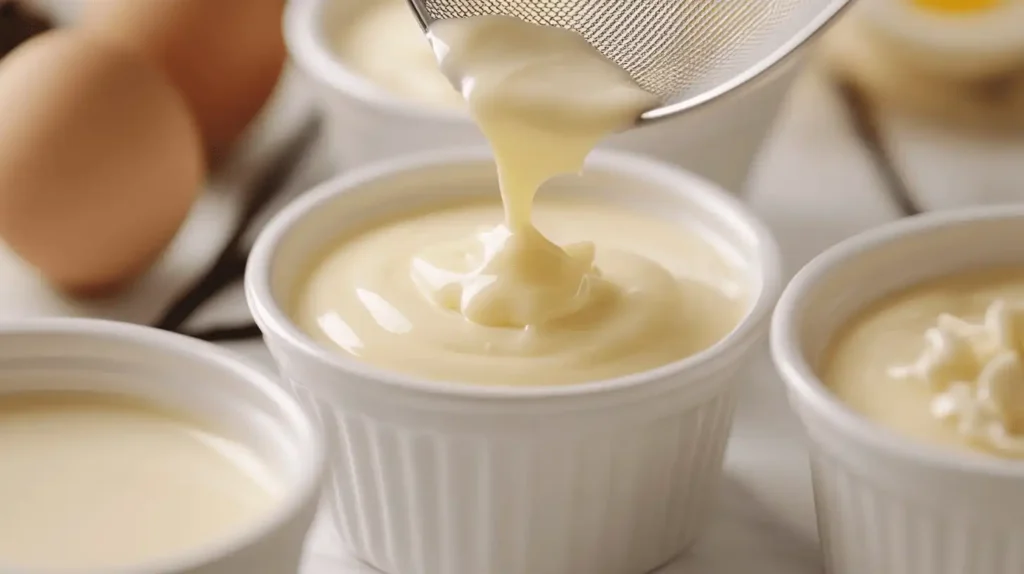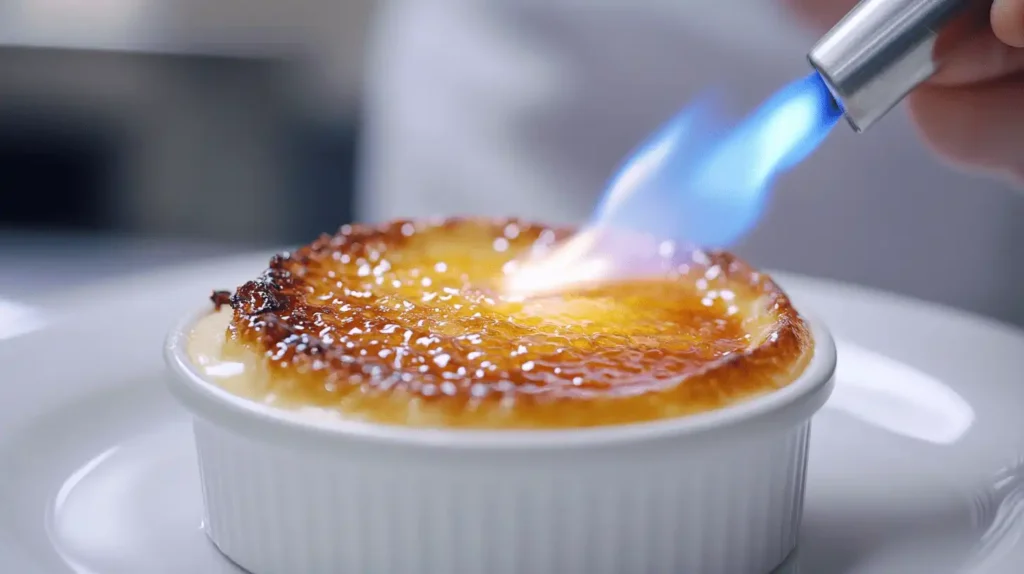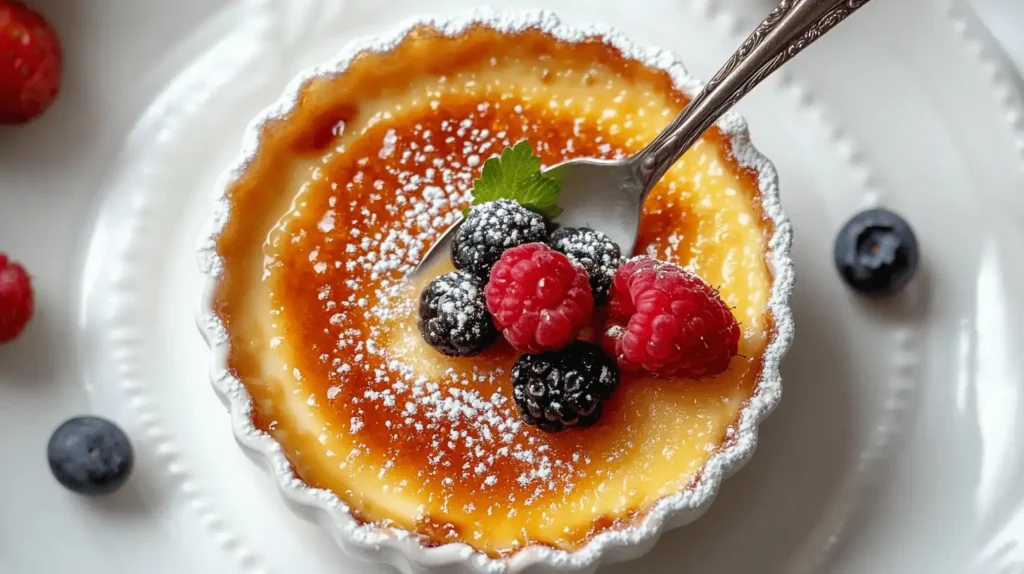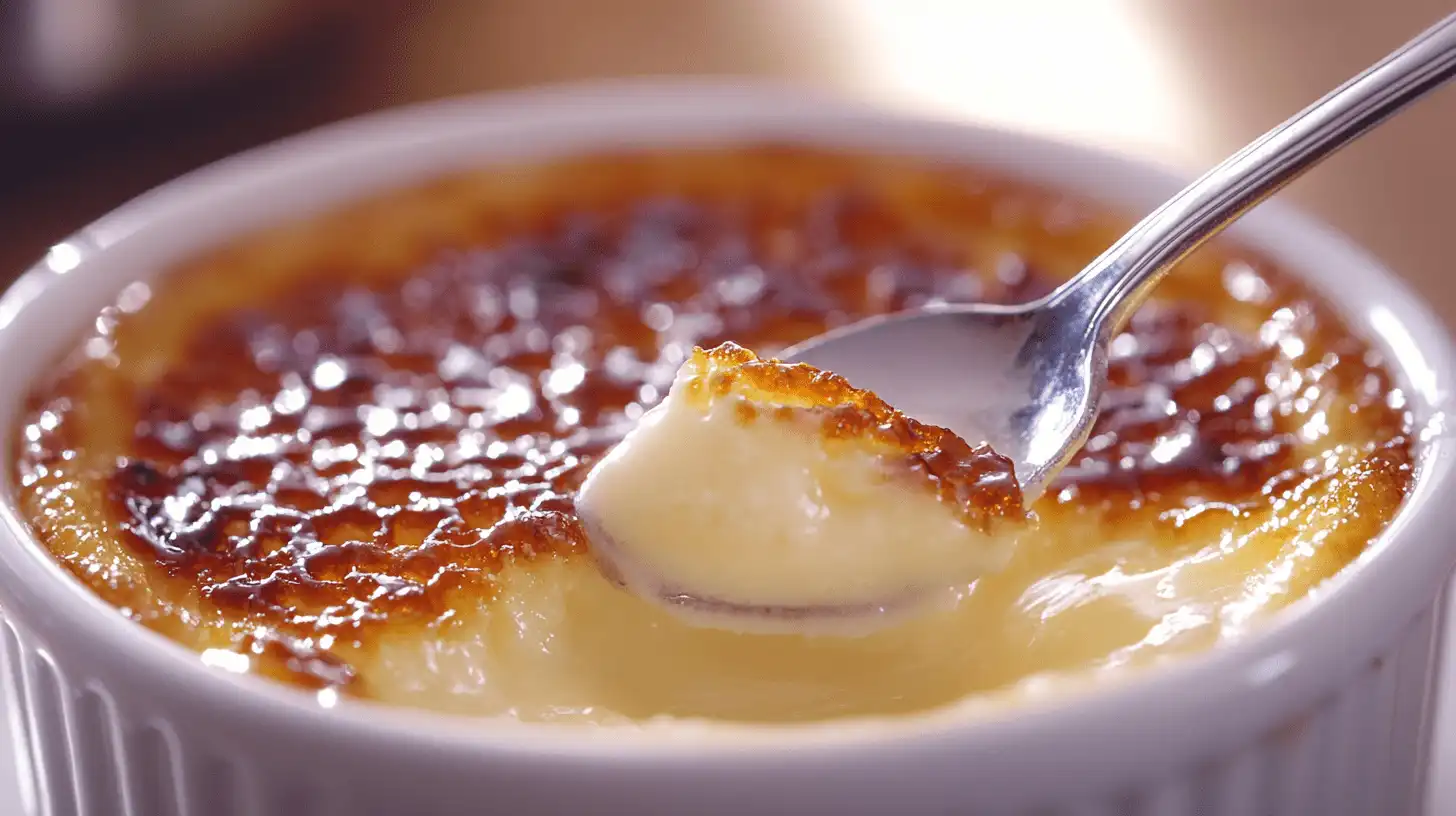What is the Secret to Crème Brûlée? This French classic, known for its rich vanilla custard and crisp caramelized sugar topping, is a favorite among dessert lovers. Despite its seemingly simple ingredients—cream, egg yolks, sugar, and vanilla—getting it just right requires skill and precision. Many home bakers struggle with curdled custard, grainy textures, or uneven caramelization.
If you’ve ever wondered how to achieve that silky-smooth custard and perfect glass-like sugar crust, you’re in the right place. We’ve gathered five expert tips that will help you master crème brûlée like a professional pastry chef.
Understanding the Science Behind Crème Brûlée
How Custard Structure Affects Texture
Crème brûlée is a baked custard dessert, meaning it relies on the careful thickening of egg yolks and cream. The yolks contain proteins that, when heated slowly, bind with the cream to create a smooth, firm structure. However, if heated too quickly or at too high a temperature, the eggs will coagulate too fast, leading to a grainy or scrambled texture.
To avoid this, it’s essential to:
✔ Mix the eggs gently to prevent air bubbles, which can cause an uneven texture.
✔ Heat the custard slowly by baking it in a controlled environment.
✔ Use fresh, high-quality eggs, as they provide better structure and richness.
Why the Water Bath is Essential
A water bath (bain-marie) is one of the most critical steps in baking crème brûlée. The ramekins are placed in a larger baking dish filled with hot water, which surrounds the custard with gentle, even heat. This ensures:
✔ Slow, even cooking to prevent overbaking.
✔ Moisture retention, which keeps the custard silky and prevents it from drying out.
✔ A consistent texture from the edges to the center.
Pro Tip: Use hot tap water instead of boiling water for the water bath. Boiling water may cause the custard to cook too quickly.
How Custard Structure Affects Texture
The key to a perfectly smooth custard is understanding how eggs and cream interact during baking. If you enjoy working with custards and fruit-based desserts, you might also like this Pineapple Casserole Recipe, which balances sweet and savory flavors in a unique way.
5 Expert Tips for the Perfect Crème Brûlée
1. Use High-Quality Ingredients for the Best Flavor
The quality of your ingredients directly affects the final taste and texture of your crème brûlée. Experts recommend:
✔ Heavy cream with high fat content (at least 35%) for a richer custard.
✔ Fresh, organic egg yolks for a smooth, velvety texture.
✔ Pure vanilla beans instead of extract for a more intense and authentic flavor.
Use High-Quality Ingredients for the Best Flavor
For a rich vanilla aroma, always opt for high-quality vanilla beans. If you’re interested in how different cooking techniques enhance fruit flavors, check out Why Grill Pineapple? to learn how caramelization can elevate natural sweetness.
How to Infuse Maximum Vanilla Flavor
To extract the best flavor from vanilla beans, follow these steps:
- Split the vanilla bean lengthwise using a sharp knife.
- Scrape out the tiny black seeds from inside the pod.
- Heat the cream with the vanilla seeds and pod, then let it steep for 10-15 minutes to infuse the flavors fully.
Why does this matter? The slow steeping process allows the cream to absorb all the aromatic compounds from the vanilla bean, making your custard incredibly fragrant and flavorful.
2. Control the Baking Temperature for a Silky-Smooth Custard
One of the biggest mistakes people make when baking crème brûlée is setting the oven temperature too high. A high temperature causes the custard to cook unevenly, leading to curdling or a rubbery texture.
✔ The ideal baking temperature is 300°F (150°C) for a slow, gentle bake.
✔ Bake until the edges are set but the center still jiggles slightly when shaken.
✔ Overbaking can cause the custard to separate and turn grainy.
Baking Time Guide:
| Oven Temperature | Baking Time | Texture Outcome |
|---|---|---|
| 275°F (135°C) | 50-60 minutes | Very creamy, soft |
| 300°F (150°C) | 35-45 minutes | Silky-smooth, ideal |
| 325°F (160°C) | 25-35 minutes | Slightly firmer |
3. Strain the Custard for an Ultra-Smooth Finish
After whisking the egg yolks and cream, it’s essential to strain the mixture through a fine mesh sieve. This step removes:
✔ Any bits of cooked egg, which can cause lumps.
✔ Air bubbles, which can create an uneven texture.
✔ Vanilla pod remnants, ensuring a perfectly smooth custard.
For best results, strain the custard directly into the ramekins to minimize the risk of bubbles reforming.

4. Chill Properly Before Caramelizing
Once baked, crème brûlée needs time to fully set before adding the sugar topping. Experts recommend refrigerating for at least 4 hours, but overnight is even better.
Why is chilling important?
✔ It enhances flavor by allowing the vanilla to develop further.
✔ A cold custard prevents melting when caramelizing the sugar.
✔ It creates a firm texture that cracks perfectly under the brûlée top.
5. Mastering the Caramelized Sugar Topping
The signature crispy sugar crust of crème brûlée requires careful caramelization. Here’s how to do it like a pro:
Choosing the Right Sugar
- Granulated sugar caramelizes evenly, creating a smooth, glass-like top.
- Brown sugar gives a deeper caramel flavor but may burn faster.
- Turbinado sugar creates a slightly crunchier crust.
How to Torch Sugar Like a Professional Chef

- Sprinkle an even layer of sugar over the chilled custard.
- Use a kitchen torch and hold it 2-3 inches away from the sugar.
- Move the torch in circles to melt the sugar gradually, preventing burnt spots.
- Let the caramel harden for 1-2 minutes before serving.
Alternative Method: If you don’t have a torch, place the ramekins under an oven broiler for 1-2 minutes, but watch closely to prevent burning.
A crisp, evenly caramelized sugar top is the hallmark of great crème brûlée. If you’re curious about how sugar and heat interact in other recipes, our guide on Does Pineapple Break Down Cheese? explains how pineapple’s natural enzymes affect dairy textures.
FAQs
What not to do when making crème brûlée?
✔ Avoid whisking too vigorously—this introduces air, causing a bubbly texture.
✔ Never skip the water bath, or the custard may bake unevenly.
✔ Don’t rush the caramelization process, or you may burn the sugar.
How to get the perfect crème brûlée top?
✔ Use fine sugar and apply it in an even layer.
✔ Torch gradually, keeping the flame moving to avoid burning.
✔ Let the caramel cool for a crisp, crackable top.
What makes a good crème brûlée?
✔ A smooth, creamy custard that holds its shape.
✔ A thin, crisp sugar layer that cracks with a spoon.
✔ A rich vanilla aroma from quality ingredients.
How to master crème brûlée?
✔ Follow precise baking times and temperatures.
✔ Use a fine mesh strainer for a silky finish.
✔ Allow proper chilling time before caramelizing.

Conclusion
What is the Secret to Crème Brûlée? The key lies in using high-quality ingredients, precise baking techniques, proper chilling, and careful caramelization. By following these expert tips, you’ll create a crème brûlée that’s restaurant-worthy—every single time.

